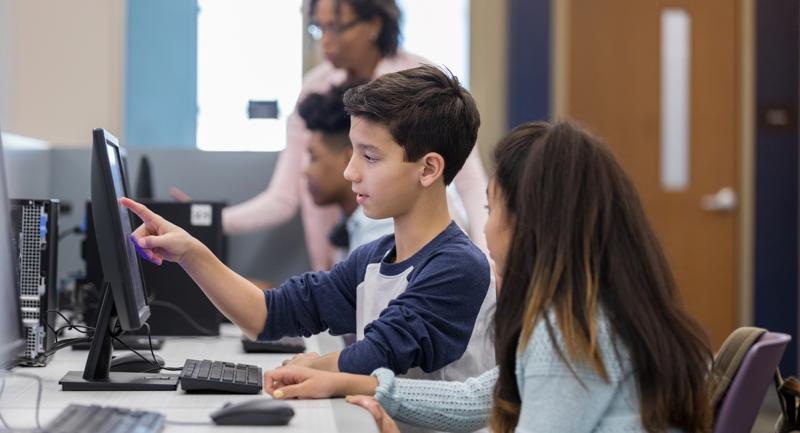Since generative AI came on the scene, teachers have been fraught over concerns about academic integrity. The ins and outs of ensuring that the work students turn in is actually their work are complex. But the advice we find on social media makes it all seem *ahem* simple: “Just build AI-proof assessments,” “Create authentic learning opportunities,” or “Change the way you teach.” The problem with these posts is that they very often do not follow-up with showing what this actually looks like.
Further, there are many companies that have popped up in the last few years that claim to be able to detect AI-generated writing. While AI detectors seem like an easy solution, they have been proven to be easily defeatable with just a little creativity. On top of the fact that they can be duped, they also continue to give false positives; I saw one teacher share that a 20-year-old term paper she uploaded was marked as 100 percent likely to be AI-generated.
Of course there are good ideas out there, too! But before we look at these possible strategies, it’s important to note that we should all be focused on the fact that teaching is meant to help students, not “catch” them. Most of my own students want to learn, not just get an A. They want to be better prepared for the unpredictable world they’re stepping into. With that in mind, let’s explore some ways we can start to assess learning in the age of AI.
Flipping the Script
In the late 2000s, the Flipped Classroom model made quite a splash, and while many loved the idea of recording lectures to have students watch as homework and then have class time dedicated to doing the actual work, many teachers found the demands of trying to create an entire term of videos overwhelming. These days, companies like YouTube and TikTok have made video creation and publishing so easy that it can be lower stress than delivering a lecture in person.
Teaching is meant to help students, not “catch” them.
If flipping a whole class is still daunting, though, you can flip a unit, a lesson, or even a single activity. The initial effort of doing so will result in more time in the classroom to help students through their work and keep them focused—and honest. When I have my students do in-class writing, I pop into their documents while they’re writing and give tiny bits of feedback. This is very easy to do if you’re using Google Classroom or Google Assignments in your LMS—just log in to your assignment and click on the name of any given student to open their document. It’s also a good check to make sure they are on track and doing their own work—and much better than the anti-AI suggestion to have them handwrite everything. When I check students’ work from my teacher station rather than walking around, I find that they are much more likely to stay on task and do it honestly, especially if they’re not sure when I’ll be in their document. To keep it from feeling like a “gotcha” moment, I do this early and often so students get used to the process and know I’m there to help them if they get stuck.
Process Tracking
Another strategy for ensuring authentic student learning is to focus on the process. Most traditional assessment is based on grading a single product: an essay, a report, a presentation. While there have always been teachers who track work as students go through systems like portfolio-building, for the most part we’ve built a culture of education that focuses on the end product. Recent concerns about whether students are actually creating the work they’re turning in are pushing more teachers to revisit portfolios or other ways of watching learning build over time. This can be done with more regular low-stakes formative assessments, like quizzes in Kahoot!, Gimkit, or the quizzing platform built into your Learning Management System.
To track the writing process, try using a tool like Process Feedback, a free, educator-developed tool that is less focused on chasing down academic integrity and more focused on helping students understand how they think and work. It can certainly be one resource to help us get a sense of whether students are doing their own work. But beyond that, we need to start showing students that we care more about the iterative process of learning, to reduce the likelihood of students just having AI whip something up minutes before a deadline.
The Elephant in the Room
These suggestions are all just part of the nebulous space we find ourselves at in education right now. We are all learning and adjusting to the constantly changing abilities of AI. The techniques shared here can be used to discourage the use of AI in the classroom, but I’d also challenge us to regularly consider where AI does fit in the classroom. As AI becomes integrated into everyday tools, neglecting tech-focused skill-building is a disservice to students. If you’re looking for a place to get started on embedding AI policies into your syllabus, Lance Eaton has built a useful repository of policies.
Though it may cause stress, for the foreseeable future we are all responsible for keeping our minds open and experimenting with different tools and approaches to assessment. Our students’ needs do not allow us to “carry on as usual,” as we no longer live in a “usual” world. We’re all in a new era of learning and teaching, and we owe it to our students to keep making adjustments that support their learning, thinking, and future success.









